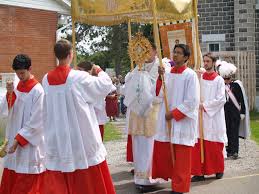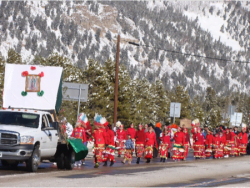
On Saturday, March 5, Archbishop Samuel Aquila, of the Archdiocese of Denver, will lead a Eucharistic Procession around Planned Parenthood. I had always wanted to be a part of a Eucharistic Procession of the Blessed Sacrament with the Missionary Image of Our Lady of Guadalupe to an abortion center.
In August of 1991, I was a Rescuer and a lawyer in the Rescue Movement. Rescuers risked imprisonment and blocked access to abortion centers by mothers and doctors to prevent their killing of the unborn children. They followed the biblical instruction to “Rescue those being dragged off to death [i.e. the unborn children].” (Proverbs 24:11). I went to Fargo North Dakota, with the Missionary Image to visit and bring consolation and prayer to imprisoned Rescuers who had rescued at the only abortion center in North Dakota, in hopes that it would close down and be the only abortion-free state in our country.
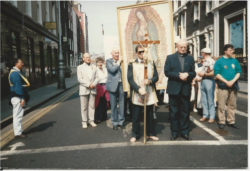
While I was there, I led a procession with the Missionary Image to the abortion center and led a Peaceful Prayer Presence there. After that, I was inspired to visit Bishop Sullivan to ask him to process the Blessed Sacrament to the Fargo abortion center. I was apprehensive about requesting an audience with the Bishop and going through the bureaucracy of the Chancery. Nevertheless, I took the right next step and tried to be a sign of hope to others.
I walked into the Bishop’s secretary’s office and asked if she could schedule an appointment for me with the Bishop. To my great surprise, she nodded and said, “Yes, he’s in his office now, why don’t you go down there to see him?”
I said, “You mean right now? Should I just go down and knock on the door?” She said, “No just walk in. The door is open.” This was the first open-door policy that I had ever encountered in any Chancery. I was encouraged that I might have a good chance to have my request granted.
So, I walked down the hallway and walked in on the Bishop who was sitting at his desk. I introduced myself and told him why I was in Fargo. Then I got right down to the point, looked him in the eye and asked him if he would ever consider leading a procession with the Blessed Sacrament and the Missionary Image to the abortion center and celebrate Benediction. He thought for a moment (really, only a moment) and said, “Yes, and we will do it.”
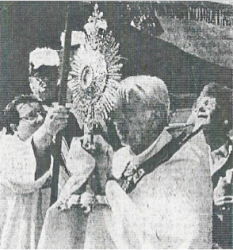
One year later on Sunday, August 16, 1992, I returned with the Missionary Image to Fargo where I participated in a procession with it, one thousand of the faithful and Bishop Sullivan who carried the Blessed Sacrament in solemn procession to the abortion center.
Teenagers carried a banner proclaiming, “TRUTH – teens rescuing unborn tiny humans.” “It’s something we wanted to do and planned for,” said a fifteen-year-old Christine Phillips. “Maybe it will help end abortion. I’m happy I’m here.”
Bishop Sullivan stood in front of the abortion center and said, “We are here today because we have sinned. We can no longer act as innocent bystanders. We cannot stand by and watch the innocent unborn washed out of the womb with saline solution and cut into pieces. We want North Dakota to be a leader so that lives will no longer be taken away in the very spot on which we stand.”
“So many people in the last few days have asked me what this is about. Those people just don’t know you. Help us, Lord, to be followers, perfect Christians, and soldiers of Jesus Christ.”
The Bishop then celebrated Benediction in front of the abortion center and later led the fifteen decade Rosary and celebrated Mass outdoors at a nearby Carmelite Monastery.
Likewise, in the summer of 1993, Bishop Paul Dudley of Sioux Falls, South Dakota, led a procession with the Blessed Sacrament and the Missionary Image to the only abortion center in the state of South Dakota. The Bishop said to the hundreds of prayer supporters, “We believe that human sacrifices are being done today through abortions, and we’re asking Mary’s prayers of intercession to bring an end to that in a non-violent, spiritual way.” The Bishop blessed the abortion center and its staff and prayed for its closure and for the conversion of the staff.
Each year thereafter, Bishop Sullivan followed the precedent that he had set. In November 2006, I had breakfast with Archbishop Aquila at the United States Bishops’ Conference in Baltimore. He had succeeded Bishop Sullivan. He told me that he had continued the precedent set by Bishop Sullivan. This year, on March 5, Archbishop Aquila will lead a Joshua Eucharistic Procession to and around Planned Parenthood in Stapleton, in the Archdiocese of Denver, circling it seven times in the manner of Joshua at the Battle of Jericho.
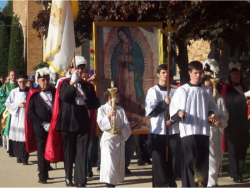
These processions are the fruit of the seeds planted by the Jews. They processed with the Ark of the Covenant, which contained the presence of God, as does the monstrance with the Blessed Sacrament in it. They processed with the Ark around the walls of the city of Jericho, until the walls fell and gave the Jews their entry to the Promised Land. (Joshua 6:1-27).
Catholic processions are sacred public processions by people in public places led by a bishop, priest, deacon, religious or lay person, with some or all of the following: the Blessed Sacrament; sacred images; banners and statues. A cross bearer leads the procession followed by the Blessed Sacrament, if present, and then the other sacred objects which are followed by clergy who must be properly attired. The men should be separate from the women, and the laity separate from the clergy, although this rubric is seldom followed and more often all are mixed in the procession.
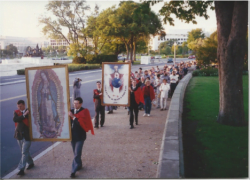
All who march in the procession should be praying. It is difficult for a large procession to pray in unison and the prayers and/or singing should be organized in advance by the leaders. The Rosary, the Litanies of the Sacred Heart, of the Divine Mercy, of the Saints or of Loreto can be prayed or sung with their respective simple responses, “Have mercy on us”, “I trust in you” or “Pray for us.” To maintain voices in unison there should be section leaders processing outside of the other processors by sections. It may be necessary to use megaphones. Suitable arrangements should be made with public authorities and local law enforcement officials for parade permits and for the safety of the participants.
The purpose of Catholic processions is to arouse the faithful’s devotion, to commemorate God’s benefits to man and to thank Him for them, to peacefully protest evil and to call upon God for further assistance. That is why they ought to be celebrated in a truly religious manner. Decorum and reverence must prevail. The procession should be orderly and dignified, not like a barbarian army. You are soldiers of Christ.
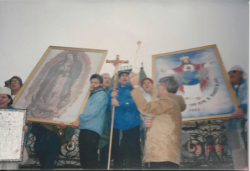
If possible, incorporate in your processions religious organizations and associations to process as groups in their uniforms, or distinctive attire, if any, such as the Knights of Columbus, the Catholic Daughters of America, etc. There should be no arguing with hecklers or others and no shouting, but a simple, prayerful witness to the love and mercy of God.
Processions give public witness of our faith that Jesus Christ, through the intercession and mediation of Our Lady, will bring the victory over our Culture of Death and bring us to a Culture of Life and a Civilization of Love, for which St. John Paul II often prayed.
Catholic processions are a form of popular piety and devotion among the faithful. (Catechism of the Catholic Church 1674). These processions extend the liturgical life of the Church, but do not replace it, and should be drawn up to lead them to it. (Catechism of the Catholic Church 1675). So it is good that a Catholic procession conclude with the celebration of Mass.
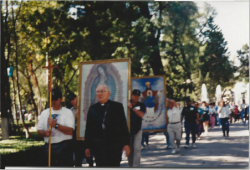
Laypeople who would like to organize a procession should contact their pastor for permission to do so. You should also ask him to participate with the Blessed Sacrament and that he request the Bishop to participate as well.
If he gives you permission, but declines to participate and to request the Bishop, you could request the Bishop yourselves or request your deacon to lead with your pastor’s consent and, if they decline, you may do it yourselves, even if you have no one’s permission. Laypersons do not need the permission of clergy or religious to have a simple lay procession with sacred images.
The instructions in this article should be read by a leader before the beginning of the procession. The mission should be explained and any special rules or instructions should be announced. Try to keep everything as simple as possible.
Kinds of Processions
Best: Procession led by a Bishop with the Blessed Sacrament and other sacred objects from a church to Planned Parenthood, or another abortion center, pornographic center or other center of evil, or, if none, loop back to the church for celebration of Mass. Those who are unable to join the procession may remain in the church interceding for the purpose of the procession until the processors return for the celebration of Mass.
Better: Procession led by a priest or deacon with the Blessed Sacrament and other sacred objects, same route, ending in Mass.
Good: Procession led by a deacon without the Blessed Sacrament, but with other sacred objects, same route, ending in a Holy Hour.
Fair: Procession led by a religious or a layperson without the Blessed Sacrament, but with other sacred objects, same route, ending in a Holy Hour.
The Order of Processors for Eucharistic Processions:
- Crossbearer, accompanied by candlebearers
- Clergy wearing copes or vestments for Mass
- Deacon of the Mass
- Censer bearer with burning incense
- Priest or Bishop carrying the Blessed Sacrament [walking under a canopy if it is used] and accompanied by torchbearers
- The people [carrying lighted candles]
Additionally:
- Suitable banners
- Musical instruments
Please click here to learn how to host a Visitation with the Missionary Image of Our Lady of Guadalupe or our other images of Jesus King of All Nations, the Divine Mercy and Our Lady of America. Then contact us to host a Visitation and/or to arrange for processions and Holy Hours with these images.
Please sign the Petition here to request the United States Bishops to honor the request of Our Lady of America to have her statue solemnly processed and displayed in the Basilica of the National Shrine of the Immaculate Conception, as a safeguard for our country, as she promised.
Authorities:
Roman ritual:
http://www.sanctamissa.org/en/resources/books-1962/rituale-romanum/55-processions-general-rules.html
Diocese of Springfield, Illinois and United States’ Bishops guidelines:
http://www.dio.org/uploads/files/Worship/Rites_to_Use/Eucharistic_Processions_Guide.pdf
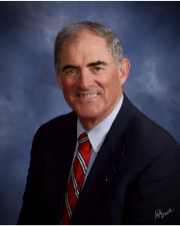 Dan Lynch is the Director of Dan Lynch Apostolates promoting devotion to Our Lady of Guadalupe, Jesus King of All Nations, Our Lady of America and St. John Paul II. He is an author, public speaker and a former judge and lawyer in Vermont. He has appeared many times on radio and television and has spoken at conferences throughout the world. You may learn more about Dan here.
Dan Lynch is the Director of Dan Lynch Apostolates promoting devotion to Our Lady of Guadalupe, Jesus King of All Nations, Our Lady of America and St. John Paul II. He is an author, public speaker and a former judge and lawyer in Vermont. He has appeared many times on radio and television and has spoken at conferences throughout the world. You may learn more about Dan here.
“May Our Lady cross this continent bringing it life, sweetness and hope!” Pope John Paul II

